QuestionHi
I am getting my pup in 2 weeks- a chocolate Lab called Rufus! We are all very excited about him coming home and have the crate, bedding, treats and a dog walker lined up for him (whilst we are out at work during the day).
I was just wondering how to take him out? We have a lot of parks by us and I know not to make him chase balls or make him jump a lot but how much exercise should he have? Should I let him off the lead straight away? Will he come back? I am prepared to walk him then carry him etc as we are keen walkers in our family.
We are also going to the south coast over Christmas where there will be a beach, obviously! Will he be ok to let off on the sand and with the water or will he get cold? I know he's a dog but he's my baby and I worry about him getting cold or drowning or something! My husband thinks I am ridiculous but he's my baby.
Many thanks for any suggestions as the walking of your dog is one of the greatest experiences and I want to get it right with Rufus from day one.
AnswerGo ahead and do plenty of walking. Don't push him if he stops or lags. I have often gone ahead and carried a puppy when I needed to walk further than it was ready for. Discourage him from running and jumping as much as you can.
Try to avoid areas frequented by dogs not known to be getting good care. The period between 6-12 weeks is a dangerous time. One sniff where a sick dog relieved itself in the last 6 months can bring on parvo or another life threatening disease. Fail to expose it to strangers, including men, women, children, noise, etc. and you could end up with a misfit you can't take out in public. They also need continuing contact with other dogs, but it must be limited to ones you know are getting good care. Early immunizations sometimes fail. The dangers of disease continue after 12 weeks, but the window of accepting new things well starts to close.
Most of my experience is in a program that forbids allowing the dog to run loose. I do think you will be OK letting him run. Do make sure you are well back from any traffic and there are no strange dogs around. When away from home, I have had little trouble with dogs staying with me.
I think he will keep back from the waves. Approach them with care. Let him investigate at his own pace. I am a little concerned about a big wave sweeping him out. After getting into the salt water, he will need a fresh water rinse.
What does a puppy need?
A crate. It is only natural that a puppy resists its crate at first. What the puppy wants more than anything else is to be others, you, anyone else in the household, and any other pets. In our modern society, even if we are home, other things distract us from the attention an uncrated puppy must have. The only real solution is to crate the dog when you can't give it tha attention it needs. The dog may be happier in its den than loose in the house. It relaxes, it feels safe in its den. It rests, the body slows down reducing the need for water and relieving its self. Dogs that have been crated all along do very well. Many of them will rest in their crates even when the door is open. Skip the bedding. At first it gets wet, and later it can be chewed into choking hazards. A wire rack in the bottom will help keep the puppy up out of accidents at first. They are available with the crates, but a piece of closely spaced wire closet shelving from a home supply place is cheaper. I think the plastic ones give the dog more of a safe, enclosed den feeling. Metal ones can be put in a corner or covered with something the dog can't pull in and chew. Select a crate just big enough for the full grown dog to stretch out in. At first, you may need to block off most of it. At bed time, with a new puppy, I have found lying down in front of the crate like you were going to sleep and speaking softly to it, or singing, until it settles down and goes to sleep works very well. Follow the pattern, a period of active play, outside to eliminate, and then into the crate.
Chew toys. The pet stores are full of toys that many dogs will quickly chew up into pieces they could choke on or cause intestinal blockages. If you are not there to watch, stick to sturdy stuff such as Nylabones and Kongs. Keep a close eye on chew toys and quickly discard anything that is coming apart in pieces. Rawhide is especially bad because it swells after being swallowed. These problems are the worst with, but not limited to, large, aggressive chewers such as Labs.
Food. Find out what the breeder is feeding. If it is dry chow you can buy readily, I would stick with it until the dog is 4 months old, at that time switching to a dry all life stages food. If not, try to have the breeder give you a few days supply to use making a gradual change to a dry puppy chow. In most cases, your best bet is to stick with the breeders food. Many people switch to ''better'' foods and have trouble.
Dishes. Empty plastic food containers are good enough. If you want something nicer, buy the spill proof? ones, stainless steel with an outer skirt making them hard to tip or pick up. I have found them at Big Lots.
A collar and leash. You should stay with a flat fabric or leather collar until your puppy is 5 months old. Then you can go with the metal slip collar with the rings on each end. Otherwise you could damage its windpipe. Put it on like this for the usual dog on the left position. Pull the chain through the one ring forming a"P". Facing the dog, slip it over its head. The free end comes over the neck allowing the other end to release pressure when the leash is slack. A five month old's head will still grow some. If you buy one that easily goes over the head, it still should come off leaving the ears when the dog finishes growing. I start the puppy out with a metal leash and switch to a leather one after the worst of the chewing is over and I need more control. The trend is away from the metal collars to Martingale or head collars. They can be used with younger puppies too.
A name, try http://www.lowchensaustralia.com/names/petnames.htm#1 and http://www.cat-dog-names.com/
A brush. Start the puppy with a soft bristle brush. They don't shed much at first, and the bristle brush will remove dirt and help control odor. When shedding becomes a problem later, switch to a slicker brush with the wire teeth.
The number of a vet. It is very hard to evaluate them. Dogs need more medical care than in the past. Many new problems are wide spread.
A book. Any book is better than none at all. I like the Monks of New Skete and their The Art of Raising a Puppy, ISBN 0-316-57839-8.
Obedience training. A good obedience class or book is about you being top dog, not about rewarding standard commands with a treat. Start obedience training the day you get the dog. Build on the foundation of housebreaking. The younger the puppy, the shorter you must keep sessions, only a few repetitions at a time. A few minutes here and there, and by the time the puppy is 4 months old, people will be impressed with what a nice dog it is.
An All Experts bookmark so you can come back for help as needed.
I didn't forget treats, shampoo, and bedding. I seldom use them.

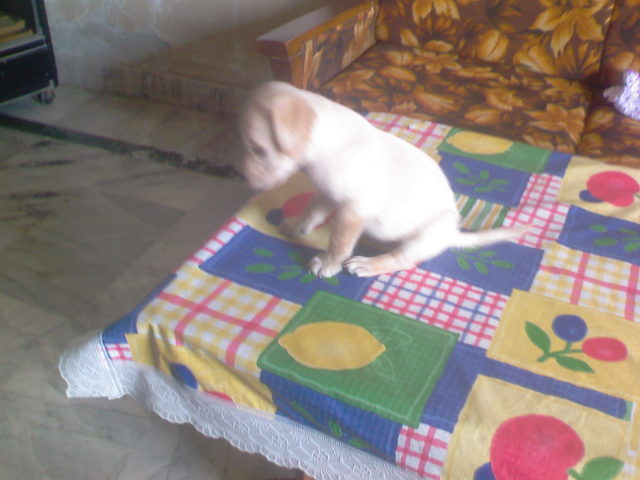 about my female dogs height
Question
sitting on table
i got a fawn coloured female
about my female dogs height
Question
sitting on table
i got a fawn coloured female
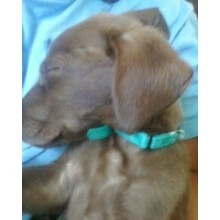 11 week old chocolate lab
Question
11 week old lab
We recently got a chocolate la
11 week old chocolate lab
Question
11 week old lab
We recently got a chocolate la
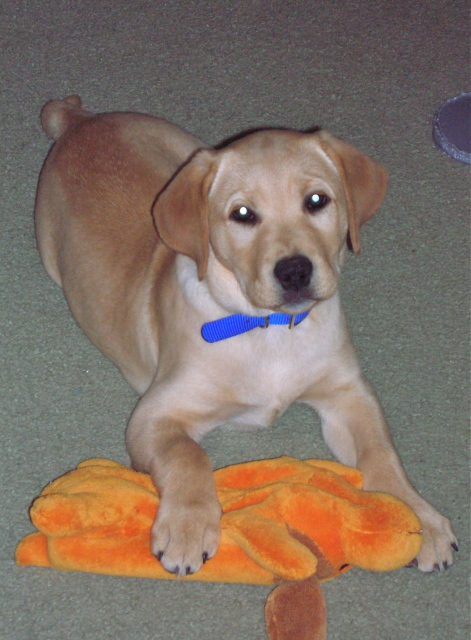 constant puppy barking
Question
My 13 week old female yellow lab barks consta
constant puppy barking
Question
My 13 week old female yellow lab barks consta
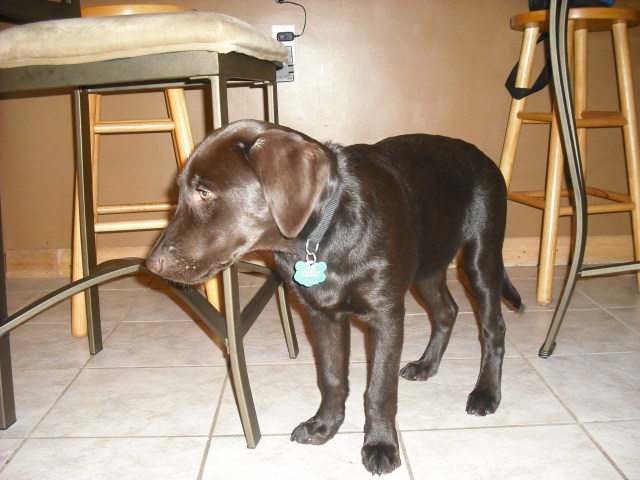 is my lab too small
Question
Reese
I have a 19 week old Male chocolate lab.
is my lab too small
Question
Reese
I have a 19 week old Male chocolate lab.
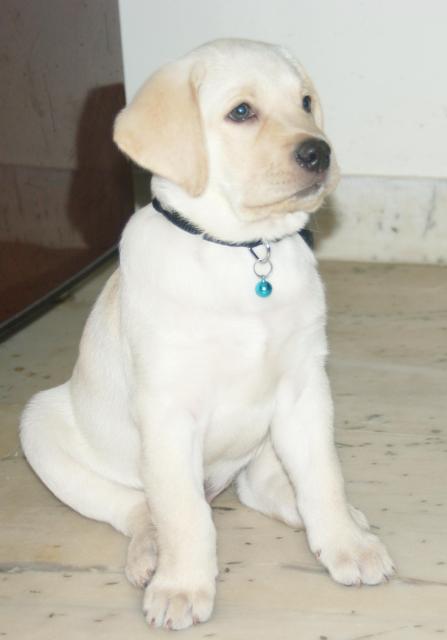 Need opinion about my Labrador Retriever
QuestionCoco (Labrador Retriev
QUESTION: I have
Need opinion about my Labrador Retriever
QuestionCoco (Labrador Retriev
QUESTION: I have